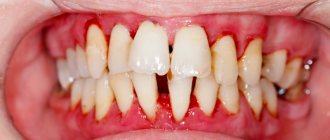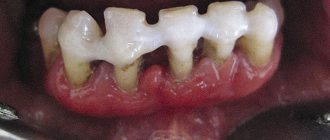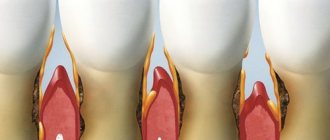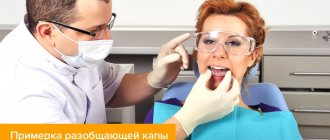Periodontitis is an inflammation of the vast majority of people
Periodontitis refers to inflammatory diseases that affect the gum tissue surrounding the tooth (periodontium), and is diagnosed to one degree or another in the vast majority of people. This is a progressive and very dangerous inflammation of the gums that destroys the tissue that supports the tooth.
If periodontitis is not treated in a timely manner, the risk of tooth loss increases many times over, so dentists never tire of warning patients that they should not delay seeing a doctor until the last minute.
At the initial stage, the symptoms of periodontitis are limited to bleeding and slight swelling of the gums, weakness of the dental ligament and discomfort when chewing, which for many people does not cause much concern. When the disease worsens, it is no longer possible to ignore the symptoms of periodontitis - severe inflammation of the gums, exposure of the neck of the teeth and purulent discharge from the periodontal pockets, pathological mobility and displacement of teeth, bad breath and enlarged local lymph nodes.
Periodontitis leads to heart disease
Periodontitis can lead to cardiovascular disease. We are talking about inflammation of the surrounding tooth tissues. This is an independent risk factor for the development of coronary heart disease, heart attacks and strokes.
Periodontitis can also cause cancer. Therefore, professional oral hygiene is needed, first of all, to prevent such violations.
Technique of flap surgery
Flap surgery in dentistry
is carried out in stages. Such an intervention requires comprehensive preparation of the patient, which will eliminate possible postoperative complications.
Step by step:
1. Preparing the patient - passing laboratory tests, sanitation of the oral cavity, including the elimination of inflammatory foci, cleaning the crowns from tartar and plaque. In case of severe tooth mobility, splinting is also performed.
2. The operation is carried out on the appointed day in a specially equipped room. The doctor treats the oral cavity with an antiseptic, administers local anesthesia and begins medical procedures: incision of the affected gum, formation of a periosteal flap, cleaning of the periodontal pocket, removal of tartar and grinding of the roots. Next, antiseptic treatment is performed again. If necessary, the doctor compensates for the bone tissue deficiency with transplant material.
3. Upon completion, the tissue flaps are sutured, an antiseptic napkin and a periodontal bandage are applied.
The attending physician gives the patient detailed recommendations for oral care during the rehabilitation period. By carefully following all instructions, you can eliminate the risk of postoperative complications.
The surgical method of treating periodontitis allows one to effectively restore the functionality and aesthetics of the dentition, which is confirmed by numerous reviews from patients who have already undergone flap surgery in Moscow clinics.
Symptoms of periodontitis
To external reasons
The occurrence of periodontitis can be attributed to the presence of tartar, irregular tooth brushing and microtrauma.
Internal causes of periodontitis
deterioration in the nutrition of periodontal tissues, endocrine disorders, blood diseases, and hypovitaminosis are considered.
To the symptoms of periodontitis
include bleeding gums, loose teeth, discomfort when chewing. At a later stage, the neck of the tooth is exposed, the lymph nodes swell and bad breath appears. All this can lead to complete tooth loss.
Indications for flap surgery for periodontitis
Flap surgery for periodontitis
involves comprehensive cleaning of periodontal “pockets” from granulations and tartar, followed by antiseptic treatment, as well as removal of excess tissue or transplantation of a flap of mucosal tissue from another area to restore the contour of the gingival margin.
Indications:
- deep exposure of roots;
- pronounced defects of gingival tissue;
- severe mobility of dental crowns;
- large gaps between crowns in a row;
- severe bleeding gums.
This operation allows you to eliminate the pathological process in the periodontal tissues, close the exposed roots and save the patient’s teeth.
Causes of periodontitis
The causes of the disease can be both general and local: in the first case, periodontitis develops against a background of weakened immunity, diabetes, blood diseases and various chronic diseases, and local causes include infections and injuries.
Microbes that produce toxins first affect the mucous membrane of the gums (gingivitis), and then penetrate into the deeper layers of tissue, destroying the supporting apparatus of the tooth.
Traumatic periodontitis occurs due to microtraumas (one-time or permanent) - to prevent it, it is recommended to avoid any mechanical impact on the gums.
During a visit to the dentist, the condition of the oral cavity is not only assessed and the origin of periodontitis is determined, but the depth of the gingival sulcus is also measured, which allows us to judge the stage of this disease. For example, if the depth of periodontal pockets does not exceed 3.5 mm, and there are no pronounced signs of exacerbation, then mild chronic periodontitis is diagnosed.
Treatment of periodontal disease, periodontitis, gingivitis
Therapeutic tactics in case of damage to periodontal tissues are determined by clinical symptoms, the extent of the process, and the severity of the disease. Since with gingivitis the tooth-gingival junction is not involved in the pathological process, the treatment provided will be simpler and limited to therapeutic measures. The features of conservative approaches in periodontology are such that with timely and well-structured dental care, you can count on the complete elimination of negative signs.
If the lesion progresses, such measures will not be possible. An integrated approach is taken as the basis, including both therapeutic measures and surgical intervention; various hardware techniques are also widely used. Modern periodontology also involves laser treatment of gums and other periodontal tissues, the use of innovative technologies, and Vector therapy. If the reason for the development of the lesion was injury to the gums by the edge of a crown or filling, then treatment should be supplemented by the elimination of these provoking factors.
Surgical periodontology: therapy and treatment of diseases
Surgical periodontology is a set of techniques that are relevant for deep and extensive pathological processes in periodontal tissues. However, even in severe situations, surgical treatment is not always taken as the basis when choosing treatment tactics. If measures such as oral hygiene procedures, anti-inflammatory therapy, and antibiotics are effective, then surgical intervention is not resorted to; conservative approaches are used.
Therapeutic periodontology
Therapeutic measures for damage to periodontal tissues begin with oral hygiene aimed at eliminating the main provoking factor in the development of pathology - hard dental plaque. These procedures are important not only for gingivitis. In case of periodontitis, by clearing the periodontal pockets of tartar, rinsing them and antiseptically treating them, it is possible to influence the causative factor and achieve a significant improvement in the situation. In modern clinics, ultrasonic teeth cleaning and an Air Flow device are used for this purpose.
The impact on pathogenic microorganisms and the inflammatory process is also achieved with the help of medications. Drug therapy at one stage or another may include:
- antiseptic solutions;
- non-steroidal anti-inflammatory drugs;
- in the presence of an infectious component - antibiotics;
- vitamins;
- biogenic stimulants, by introducing them into the gum tissue, experts try to improve local trophic processes;
- agents that promote healing and epithelization of the mucosa.
Conservative approaches also include laser action, the Vector apparatus, physiotherapeutic procedures, vacuum therapy, and ozone therapy.
Treatment methods for periodontal pathology directly depend on the clinical symptoms and severity of the process. It will be possible to achieve recovery only with the initial signs of the disease. The ineffectiveness of therapeutic approaches leads to the fact that the nature of treatment measures will be to stabilize the condition and prevent tooth loss.
Vector therapy
The operation of the Vector device is ensured by converting an electrical signal into an ultrasonic wave, with the help of which it is possible to thoroughly clean periodontal pockets, qualitatively eliminate dental deposits when they are localized subgingivally, and carry out prevention after completion of periodontal treatment. The technique is also effective in severe cases:
- deepening of periodontal pockets up to 11 mm;
- the presence of bleeding gums, suppuration from gum pockets.
During the procedure, there is no direct contact of the device head with the tissues of the oral cavity. At the same time, the simultaneous supply of a highly dispersed suspension ensures the washing out of dental plaque and polishing the tooth root.
Splinting teeth
Splinting is carried out to strengthen mobile teeth and prevent the progression of their loosening process. The desired result is achieved by using orthopedic techniques, crowns, clasp dentures, and fiberglass. Horizontal laying of a special thread connects the teeth to each other. The resulting strong contact increases the stability of the segment. As a result of the procedure, it is possible to prevent not only further loosening of the teeth, but also to fully restore their chewing function and appearance.
Indications for surgery
When deciding when an operation within the framework of surgical periodontology is indicated, specialists proceed from clinical signs. At the same time, doctors understand that this approach is less desirable compared to conservative treatment: it is associated with painful sensations, the need for sufficient anesthesia, and a recovery period. However, if conservative methods are ineffective, the pathological process will progress and bone tissue will be involved, which will worsen the further prognosis and the chances of saving natural teeth.
The indication for surgical intervention is the unfavorable course of the disease and the low effectiveness of therapeutic methods. For mild damage to periodontal tissue, one of the curettage methods is used; for moderate and severe damage, preference is given to flap surgery. X-ray diagnostics help in choosing the most correct tactics, allowing you to most accurately determine the depth of the periodontal pocket.
Surgical periodontology
For periodontal pathology, the following surgical techniques are most in demand:
- Open and closed curettage. The task facing these procedures is to cleanse periodontal pockets from tartar and granulation tissue. The choice of the most optimal technique is determined by their depth. Closed curettage is carried out somewhat simpler, without preliminary tissue incision, so it is used for slight deepening of periodontal pockets. The open curettage technique implies an extended scenario. It is used for more severe disease. In this case, an incision is made in the area of the interdental papillae, which guarantees convenience during cleansing procedures and increases the effectiveness of the procedure;
- Flap surgery allows you to relieve signs of inflammation, correct the gum edge, and restore bone tissue. The intervention is performed by peeling off the mucoperiosteal flap. This surgical approach allows you to eliminate granulations as efficiently as possible, clean and polish the roots of the teeth. Filling bone pockets with osteoplastic material makes it possible to speed up the process of tissue regeneration and restoration. The final stage of the operation is to return the flap to its original place and fix it with sutures in the interdental spaces;
- Autotransplantation. When bone tissue is involved in the pathological process, it is replaced by granulation tissue, the tooth root is exposed, which contributes to the aggravation of the situation, the development of an aesthetic defect, and also increased tooth instability. Gum transplantation is a common periodontal operation aimed at solving the problem of gum loss. If there is a shortage of soft tissues, they are taken from another part of the oral cavity, the palate.
Surgical treatment of periodontitis
Treatment of periodontitis takes place in several stages
. If therapeutic approaches, hygiene procedures, and local use of medications do not give the desired effect, proceed to surgical periodontology methods. The task facing them is the removal of dental plaque in the area of periodontal pockets and subsequent sanitation. The result is achieved by performing closed or open curettage. If lost bone tissue needs to be restored, targeted tissue regeneration is provided. The technique of such an operation is the simultaneous use of osteoplastic materials, membranes and grafts, which can significantly improve the process of osteogenesis. In this case, the positive effect of treatment is observed at any degree of damage.
Surgical periodontology in Moscow
widely represented in the Dental Studio clinic. Treatment of these diseases is carried out by specialists with specialized education and extensive experience in using both conservative and surgical techniques. An individual approach is applied to each patient, taking into account the entire range of associated factors. Properly prescribed and carried out therapeutic measures provide a positive prognosis for the disease. This area of activity of our doctors finds a positive response among patients.
Non-surgical methods for treating periodontitis
There are 2 treatment methods that exclude surgical intervention:
- Splinting – helps protect teeth from displacement or loss. An orthodontic design can eliminate tooth mobility and firmly fix them in their normal position. To do this, specialists use fixed and removable structures, depending on the severity of the disease.
- Closed curettage – makes it possible to eliminate the lesion in periodontal pockets with a depth of no more than 5 millimeters. The work is performed using local anesthesia. The specialist removes hard plaque, tartar and inflamed tissue, and also fixes the roots of the teeth in the correct position. A control check of the achieved result is performed 30 days after the operation.
Recommendations after treatment
After the operation, you need to follow 4 rules:
- Any physical activity and stress are prohibited.
- You must not overcool or overheat (you cannot go to the bathhouse or take a hot shower).
- You need to exclude hard, sweet, sticky, spicy, salty foods from your diet for a period of 7 days. Preference should be given to light and soft foods so as not to injure the gums.
- Do not brush your teeth with a hard brush, or touch the treated gum with your tongue or hard objects.
The specialist will prescribe you antiseptic mouthwashes and antibiotics to prevent the development of infection. In combination with oral hygiene, gels are prescribed that protect the enamel and gums from the proliferation of pathogenic bacteria, and also accelerate tissue restoration.
Schemes for surgical treatment of periodontitis
If during the consultation the specialist accurately diagnosed periodontitis, then treatment will begin with conservative methods.
Deep teeth cleaning is a conservative treatment that is prescribed first. Hard plaque and tartar formed due to irregular or improper oral hygiene are eliminated. Hard plaque and the accumulation of pathogenic bacteria can lead to the destruction of deep gum tissue and ligamentous apparatus, which will weaken the fixation of teeth in the affected area. A specialist removes deposits 100% using an ultrasonic device.
Coating with fluoride varnish – replenishes the lack of fluoride and protects against external influences, including pathogenic bacteria. It is carried out in combination with professional ultrasonic cleaning. Imported and domestic gels and varnishes are used (domestic ones can give the teeth a yellow tint). The persistence of pathology without visible improvements after conservative treatment is a serious reason for surgical intervention. Otherwise, the client will face very serious complications.
Open curettage - the operation is performed with local anesthesia and makes it possible to clean pockets with a depth of more than 5 millimeters. Cleaning is carried out after the incision and detachment of the gums using curettes. Ultrasound is used to eliminate the source of inflammation. Next, osteoplasty is used to speed up bone tissue regeneration. The last step is to apply sutures to the cut gum.
Gingivectomy - the procedure is performed under general anesthesia or local anesthesia. Performed to remove overgrown tissue near the gum. Additionally, periodontal pockets are removed, which helps eliminate pathological processes in bone tissue and roots.
Gumplasty – used in combination with open curettage to restore the healthy appearance of the gums. The surgeon removes excess tissue and restores normal shape and height. Anesthesia is carried out with general anesthesia or local anesthesia.










